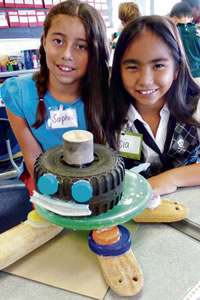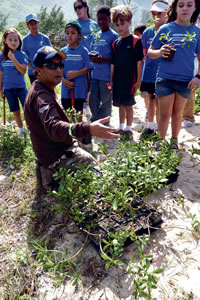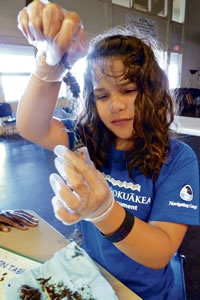School of Bird Barf
A new program gets students outdoors to learn about native species, and to dissect albatross boluses. Thanks to a curriculum developed for elementary schools by the National Oceanic and Atmospheric Administration (NOAA), young students are receiving hands-on lessons they won’t soon forget.

By .(JavaScript must be enabled to view this email address)
E-mail this story | Print this page | Archive | RSS

|
There’s getting your hands dirty and then there’s getting your hands dirty! Thanks to a curriculum developed for elementary schools by the National Oceanic and Atmospheric Administration (NOAA), young students are receiving hands-on lessons they won’t soon forget.
“(As part of the program with NOAA) our fourthgraders had a chance to go out to Camp Erdman,” says Island Pacific Academy (IPA) teacher Joe Krueger. “It was a chance for the kids to get their hands on native plants and to actually dissect some albatross boluses.”
Some what?
“To be straightforward,” laughs NOAA’s Matthew Limtiaco, “it’s albatross barf.”
Before a fledgling albatross takes flight, it regurgitates a mass of undigested objects. The boluses often include bits of plastic that parents inadvertently collect while scavenging for food in the ocean. They then pass the shards to their young.
The NOAA curriculum, called “Navigating Change,” is meant to instill in the students a new respect for their surroundings.
“Navigating Change was Nainoa Thompson’s father,” explains Limtiaco. “Nainoa took that torch and passed it on to educators from the National Oceanic and Atmospheric Administration.”
Those same values that shaped the Polynesian Voyaging Society were compiled into a classroom guidebook. The semester-long course teaches the children about environmental stewardship, includes guest speakers, and culminates in first-hand field experience.

|
When Limtiaco himself a teacher for eight years with the DOE came on board with Navigating Change three years ago, he noticed that schools were fine with implementing the classroom segment of the curriculum, but translating those lessons into tangible, outdoor experience was another story, what with transportation logistics, safety issues and knowing where to get involved.
His solution was to have the kids work on projects near their schools. Students from the Maunalua Bay area (Hawaii Kai) participated with Malama Maunalua to remove invasive algae and did native plant restoration at Paiko Wildlife Sanctuary. A total of eight schools in Hilo, Waimea and Kona did restorative work in nearby forests.
IPA was one of a few West side schools Limtiaco worked with this past school year, also partnering with Friends of Kaena, YMCA Camp Erdman and the state Division of Forestry and Wildlife to deliver Intro 101 on what Limtiaco calls “the Grand Canyon in their backyards” Northwestern Hawaiian Islands.

|
“The first stage (of last year’s program) was introducing Papahanaumokuakea National Monument to students,”
says Limtiaco. “It’s the Northwestern Hawaiian Islands. A lot of the students don’t even know it exists. It doesn’t show up on all maps, but it includes 10 islands and atolls that extend past Kauai and Niihau. They’re all part of this Hawaiian island archipelago and they include important historical islands like Midway Atoll, also known as ‘voices of the birds.’
“At last count there were more than 400,000 breeding pairs of albatross there, but a number of them took a hit during the last tsunami. So other colonies on these islands are also very important.”
Limtiaco pointed out that for learning purposes, Kaena Point works perfectly as a stand-in for Papahanaumokuakea because of its literal and metaphorical link to Northwestern islands. Both places are geologically similar and they’re home to the same species of sea and
Page 1 of 2 pages for this story 1 2 >
E-mail this story | Print this page | Comments (0) | Archive | RSS
Most Recent Comment(s):








